This document presents a comparative study of denoising 1-D data using wavelet transform. It studies the impact of different levels of decomposition and thresholding criteria (hard or soft) on output signal-to-noise ratio and mean square error when denoising four synthetic signals (blocks, bumps, doppler, heavy sine) corrupted with white noise using discrete wavelet transform. The results show that for blocks and bumps signals, soft thresholding produced higher output SNR and lower mean square error compared to hard thresholding. Higher levels of decomposition also led to better denoising for blocks but not for bumps.
![E-ISSN: 2321–9637
Volume 2, Issue 1, January 2014
International Journal of Research in Advent Technology
Available Online at: http://www.ijrat.org
216
A COMPARATIVE STUDY OF DENOISING 1-D
DATA USING WAVELET TRANSFORM
Hemant Tulsani 1
, Rashmi Gupta 2
1 2
Electronics and Communication Department
1 2
Ambedkar Institute Of Advanced Communication Technologies And Research
New Delhi-110031, India
1
hemanttulsani@gmail.com
ABSTARCT:
In this paper, discrete wavelet transform (DWT) for noise removal has been studied over four different
types of synthetic data. These are blocks signal, bumps signal, doppler signal and heavy sine signal. These
signal sets are first corrupted with white noise and then DWT is used for noise removal. The impact of
different levels of decomposition along with the type of thresholding criterion, hard or soft, over output
signal to noise ratio (SNR) and mean square error is presented. The waveforms of original and
reconstructed signals for all levels of decomposition is also presented in the paper. All simulations are
done in MATLAB.
Keywords: Wavelets based denoising, Signal decomposition, Hard Soft Thresholding
1. INTRODUCTION
Role of signals and systems is important in all aspects of modern technologies. However, a certain amount of
unwanted signal i.e., noise is always introduced in digital signals. The noise is generally introduced while
acquisition and transmission of data signals.
Introduction of noise in any signal degrades the quality of signal as well as the information content of the signal
is lost to some extent. Hence, it is highly necessary to remove noise from the signal so that the information can
be recovered from it. This type of signal restoration which is associated with an attempt of removal of noise
from a signal is known as denoising. Noise is considered to have higher frequencies compared to signal. Hence,
filtering was the most popular technique applied for denoising applications. Different linear and non-linear
filters are proposed by researchers. Some examples of filters are mean filter, median filter, least mean square
(LMS) filter, wiener filter, etc. Research in this field has led to development of new denoising techniques such
as optimal estimate methods, spectral subtraction methods, general and genetic matching pursuit methods.
However, the newest approach in this field is denoising using wavelet transform method.
The traditional methods for denoising were based on the Fourier transformation and the short-time Fourier
transformation [13] but the analysis effects of them were not good enough as the requirement was time
frequency representation of signal. In Fourier transformation, the signal analysis is done completely in
frequency domain. It can only analyze what frequency components exist in the signal. Hence, the time and
frequency information could not be analyzed at the same time. The concept of short-time Fourier transformation
(STFT) analysis is a bit different and comparatively better. It used the concept of windowing the signal i.e.,
analyzing only a small section of the signal at a time.
To overcome the resolution problem in traditional approaches, the wavelet transform was introduced. The
wavelet transformation is a time-frequency signal analysis tool having characteristics of Multi-resolution
Analysis (MRA) [12]. It has an ability to represent signal's partial characteristic in both time and frequency
domain. Hence, it is a kind of time-frequency localization analysis method. Another characteristic of wavelet
transform is that the width of window function is variable. The window function is known as mother wavelet (a
signal with tiny oscillations and which does not lasts forever). Hence, the wavelet transform is translated and
dilated version of a mother wavelet.](https://image.slidesharecdn.com/paperid-21201498-140828020852-phpapp01/75/Paper-id-21201498-1-2048.jpg)
![E-ISSN: 2321–9637
Volume 2, Issue 1, January 2014
International Journal of Research in Advent Technology
Available Online at: http://www.ijrat.org
217
The discrete wavelet transform and it's variants is based on dyadic decomposition of a input signal into
approximation and detail coefficients. Based on the methodology employed in decomposition of signals,
wavelet transform may be termed as Discrete Wavelet Transform (DWT) or Discrete Wave Packet Transform
(DWPT) [11] [12]. In DWT, only the approximation coefficients at each level are further decomposed. In
DWPT, detail coefficients along with approximation coefficients are decomposed. Discrete wavelet transform
(DWT) is a powerful tool using multi-resolution analysis (MRA) to analyze a signal. It has been used in speech
recognition systems, signal and image compression and denoising.
2. METHODOLOGY
The basic methodology is used in noise removal in wavelet domain is shown in Figure 1.
2.1. Forward Transform
Input signal is transformed to wavelet domain using discrete wavelet transform.
2.2. Threshold Calculation
Removal of noise from a signal using wavelets is based on thresholding technique called wavelet thresholding.
It is a non-linear technique. In this, some of the wavelet decomposed coefficients particularly detail coefficients
which contain noise elements which are less than a predefined or dynamically computed threshold are made
zero. Hence, this process is also known as wavelet shrinking [1]. Selecting an appropriate threshold is a topic of
utmost importance as the efficiency of the algorithm entirely depend on its selection [2].
Fig. 1. Methodology
Input Signal
Forward
Transform
Threshold Calculation
Threshold Application
Reconstructed Signal
Inverse
Transform](https://image.slidesharecdn.com/paperid-21201498-140828020852-phpapp01/75/Paper-id-21201498-2-2048.jpg)
![E-ISSN: 2321–9637
Volume 2, Issue 1, January 2014
International Journal of Research in Advent Technology
Available Online at: http://www.ijrat.org
218
Global and Level dependent Threshold
The calculation of threshold may or may not depend on the decomposition levels. If a threshold value is
selected for each decomposition level , then the threshold is said to be level dependent threshold. However, if a
same threshold value is calculated for coefficients at all levels, then the threshold is termed as global threshold
[3] [14].
Various functions have been proposed to calculate an appropriate threshold value. Most accepted of those
include VisuShrink and SureShrink. These are explained below.
VisuShrink
VisuShrink was introduced by Donoho [6]. It uses a threshold value t that is proportional to the standard
deviation of the noise. It follows the hard thresholding rule. It is defined as:
2logt nσ= . (1)
2
σ is the noise variance present in the signal and represents the signal size or number of samples. An estimate
of the noise level was defined based on the median absolute deviation given by:
{ }( )1
1, : 0,1,...,2 1
0.6745
j
j kmedian d k
σ
−
− = −
= . (2)
where 1,j kd − corresponds to the detail coefficients in the wavelet transform.
VisuShrink can be viewed as general-purpose threshold selector which provide near optimal error properties. It
also ensures that the estimates are as smooth as the true underlying functions.
Major drawbacks of VisuShrink include overly smoothed reconstructed signals as it removes too many
coefficients, only applicable to signal corrupted with AWGN, and following of global thresholding scheme.
SureShrink
A threshold chooser based on Stein’s Unbiased Risk Estimator (SURE) was proposed by Donoho and Johnstone
[6] and is called as SureShrink. It is a combination of the universal threshold and the SURE threshold. This
method specifies a threshold value for each resolution level in the wavelet transform which is referred to as level
dependent thresholding. The goal of SureShrink is to minimize the mean squared error, defined as
( )2
2
, 1
1
MSE ( , ) ( , )
n
x y
z x y s x y
n =
= −∑ . (3)
where ( , )z x y is the estimate of the signal while ( , )s x y is the original signal without noise and n is the
length of the signal. SureShrink suppresses noise by thresholding the empirical wavelet coefficients.
The SureShrink threshold t∗
is defined as
min( , 2log )t t nσ∗
= . (4)
where t denotes the value that minimizes Stein’s Unbiased Risk Estimator, σ is the noise variance computed as
in case of VisuShrink, and n is the length of the signal. The thresholding employed is adaptive, i.e., a threshold
level is assigned to each dyadic resolution level by the principle of minimizing the Stein’s Unbiased Risk
Estimator for threshold estimates. It is smoothness adaptive which means that if the unknown function contains
abrupt changes in the signal, the reconstructed signal also does.](https://image.slidesharecdn.com/paperid-21201498-140828020852-phpapp01/75/Paper-id-21201498-3-2048.jpg)
![E-ISSN: 2321–9637
Volume 2, Issue 1, January 2014
International Journal of Research in Advent Technology
Available Online at: http://www.ijrat.org
219
2.3. Threshold Application
After calculating a threshold value, a thresholding function ( )f x is required which is applied to threshold the
coefficients. This function is dependent upon the threshold value t . There are two general categories to
threshold function. They are hard threshold and soft threshold functions [8]. The hard threshold function [7] can
be expressed as:
( )
0
h
x x t
f x
otherwise
≥
= . (5)
Hard threshold function is known to retain the sharp features of the signal however, it may mistake noise for
true signal.
The soft threshold function [5] can be expressed as:
( )
( )
0
s
sign x x t x t
f x
otherwise
− ≥
= . (6)
Soft Threshold function is known to perform well in smooth regions but it over smooth sharp features. Hence
the sharp characteristics of signal are lost.
Therefore, a new threshold function, hard-soft threshold was presented which unifies soft and hard threshold and
may retain the chief signal features and at the same time, be possible to meet the smoothness requirements. The
expression for hard-soft threshold is given below:
( )
( ) 0 1
0
s
sign x x t x t
f x
otherwise
α
α
− ≥ = ≤ ≤
. (6)
The parameter α (scaling factor) defines the boundary between the hard and soft thresholding. If 1α = , the
function follow soft threshold while 0α = follow hard threshold. The choice of 0< 1α < tend to overcome the
drawbacks of both hard and soft threshold functions.
The different threshold functions are shown in Figure 2. It can be inferred that hard threshold function keeps all
the values of the signal for x t≥ while completely removes all other values. Soft threshold function works
similar to hard threshold except that it scales down the values. Hard soft threshold function provides a
compromise between the other functions.
Fig. 2. Different threshold functions](https://image.slidesharecdn.com/paperid-21201498-140828020852-phpapp01/75/Paper-id-21201498-4-2048.jpg)
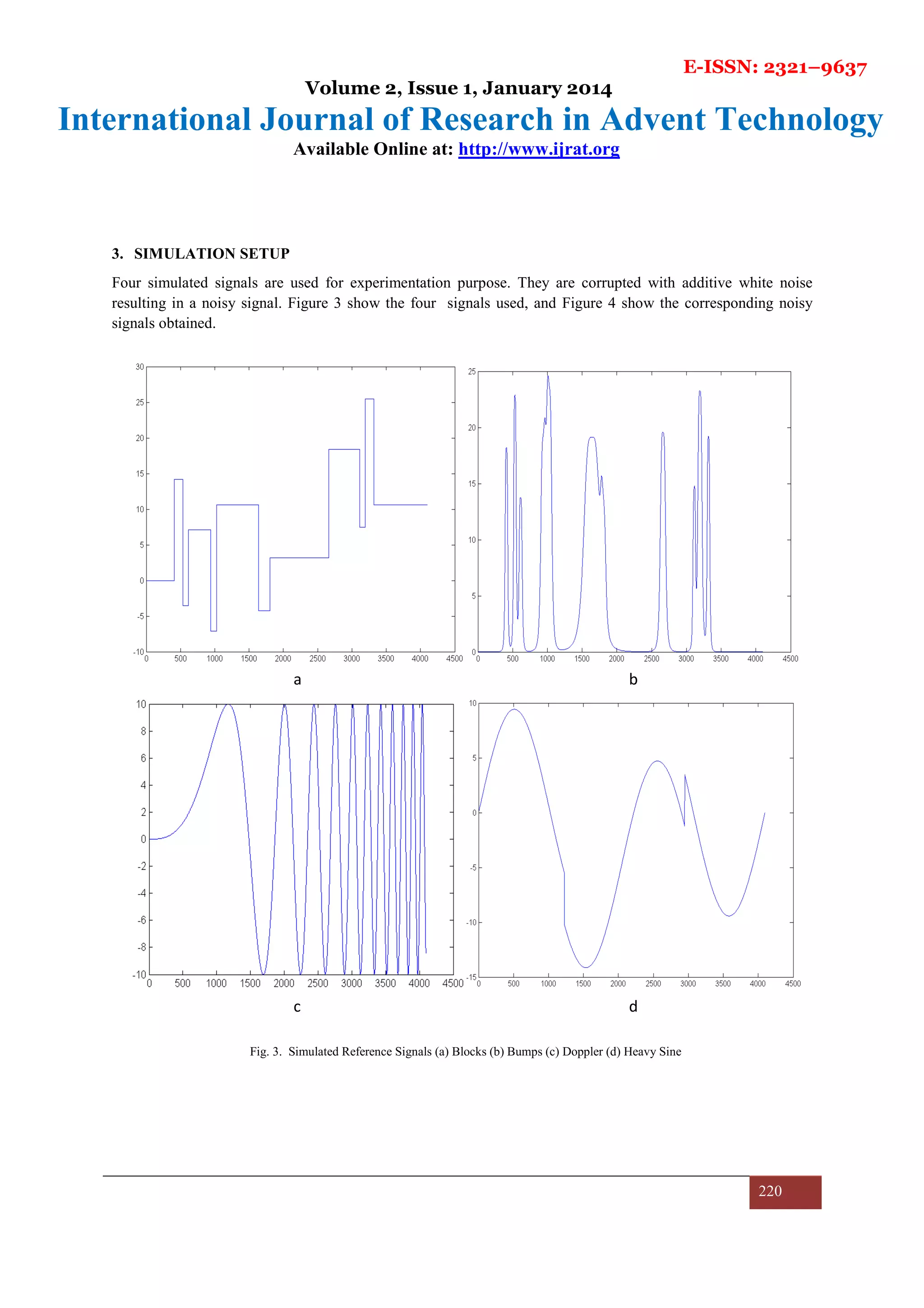
![E-ISSN: 2321–9637
Volume 2, Issue 1, January 2014
International Journal of Research in Advent Technology
Available Online at: http://www.ijrat.org
221
To compare the performance of proposed threshold selection algorithms and wavelet decomposition algorithms
for one dimensional data, few parameters [9] [10] have to be computed for each case. The signal notations
followed in this text are tabulated in Table 1.
a b
c d
Fig. 4. Simulated Noisy Signals (a) Blocks (b) Bumps (c) Doppler (d) Heavy Sine](https://image.slidesharecdn.com/paperid-21201498-140828020852-phpapp01/75/Paper-id-21201498-6-2048.jpg)
![E-ISSN: 2321–9637
Volume 2, Issue 1, January 2014
International Journal of Research in Advent Technology
Available Online at: http://www.ijrat.org
222
Table 1. Signal notations.
Notation Signal
[ ]s n Reference Signal
[ ]w n Noise signal
[ ]z n Noisy Signal
[ ]y n Reconstructed Signal
Input Signal to Noise Ratio:
It is defined as
[ ]
[ ]
2
1
10 2
1
10log
N
i
i N
i
s i
SNR
w i
=
=
=
∑
∑
. (7)
Output Signal to Noise Ratio:
It is defined as
[ ]
[ ] [ ]{ }
2
1
10 2
1
10log
N
i
o N
i
y i
SNR
s i y i
=
=
=
−
∑
∑
. (8)
o
SNR should always be greater than i
SNR . Higher the o
SNR compared to i
SNR , better the algorithm.
Mean Square Error:
It is defined as
[ ] [ ]{ }
2
1
1 N
i
s i y i
N
ε
=
= −∑ . (9)
Mean square error value should be minimum for better algorithm.
The wavelets used for evaluation purposes are haar for blocks and db8 for rest signals. The threshold selector
used is universal threshold selector or VisuShrink. Different decomposition levels are also compared for
performance evaluation which are 4, 5, 6, 7, 8 and 9. The results for soft and hard thresholding criterion are also
compared.
4. RESULTS AND DISCUSSION
The results are compiled for each signal discussed in previous section one by one. First, the results of denoising
noisy Blocks signal, Bumps signal, Doppler signal, Heavy Sine signal for all levels of decomposition are shown
in figures 5, 6, 7 and 8.
The computed performance parameters are listed in Table 2.](https://image.slidesharecdn.com/paperid-21201498-140828020852-phpapp01/75/Paper-id-21201498-7-2048.jpg)
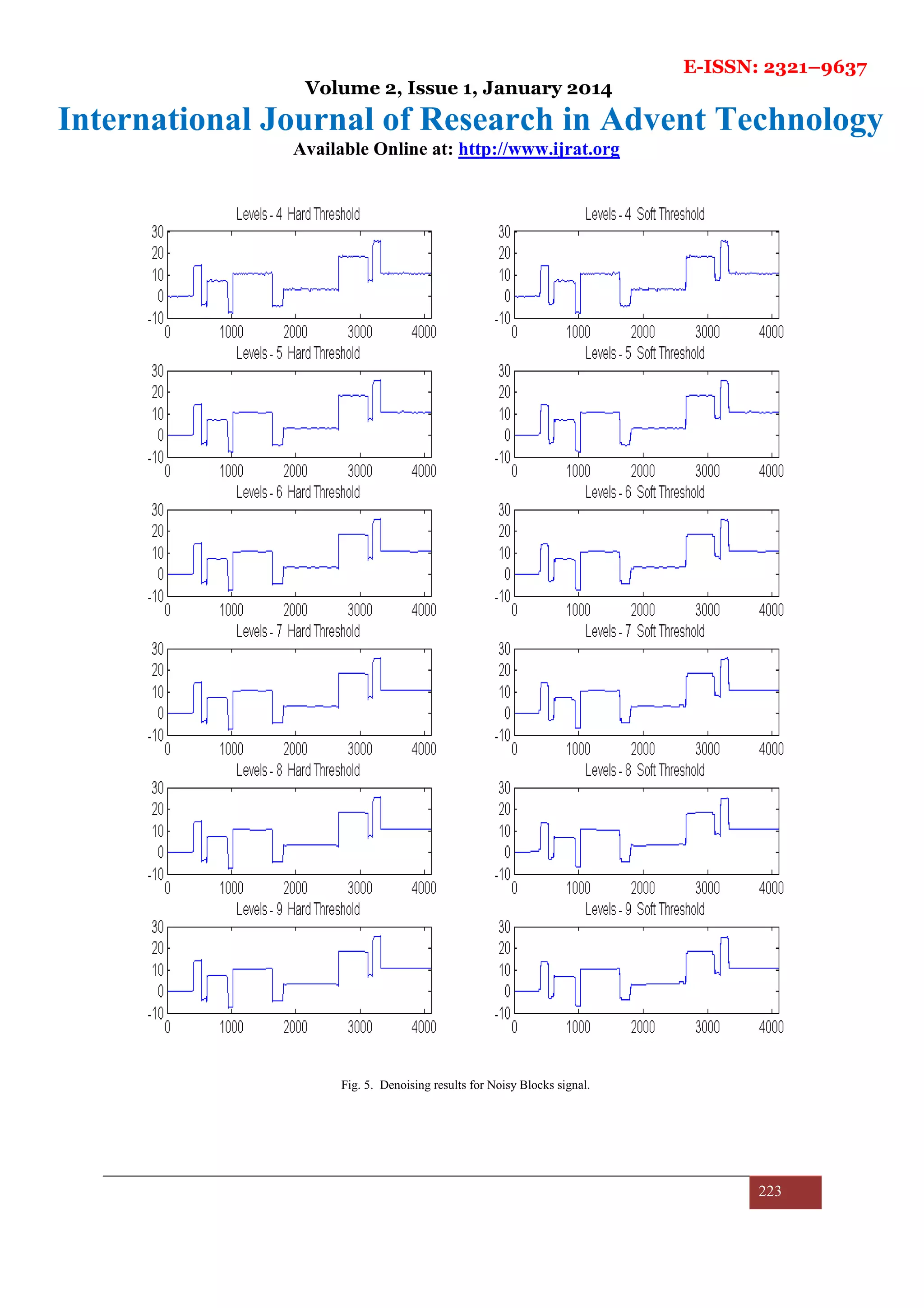
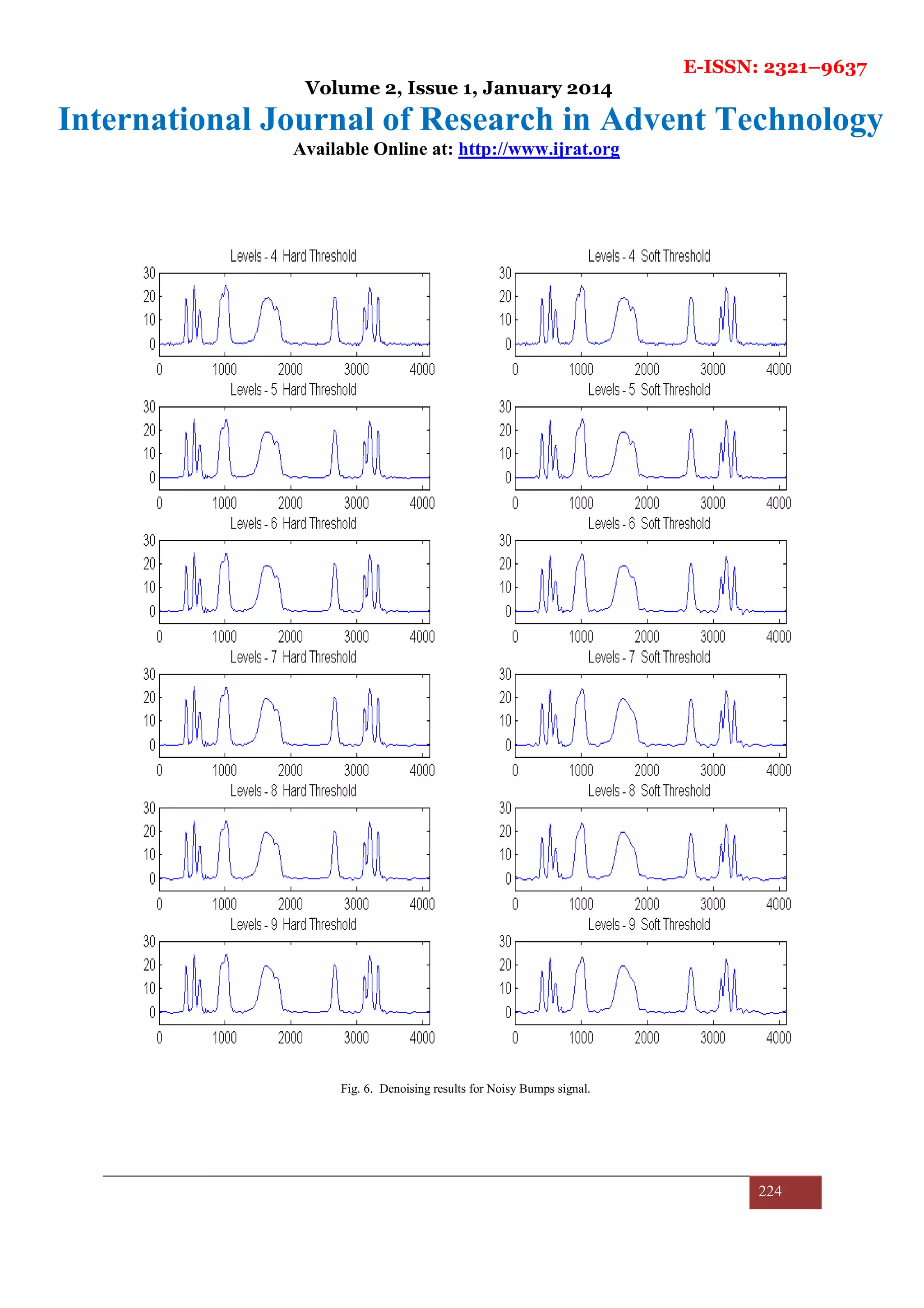

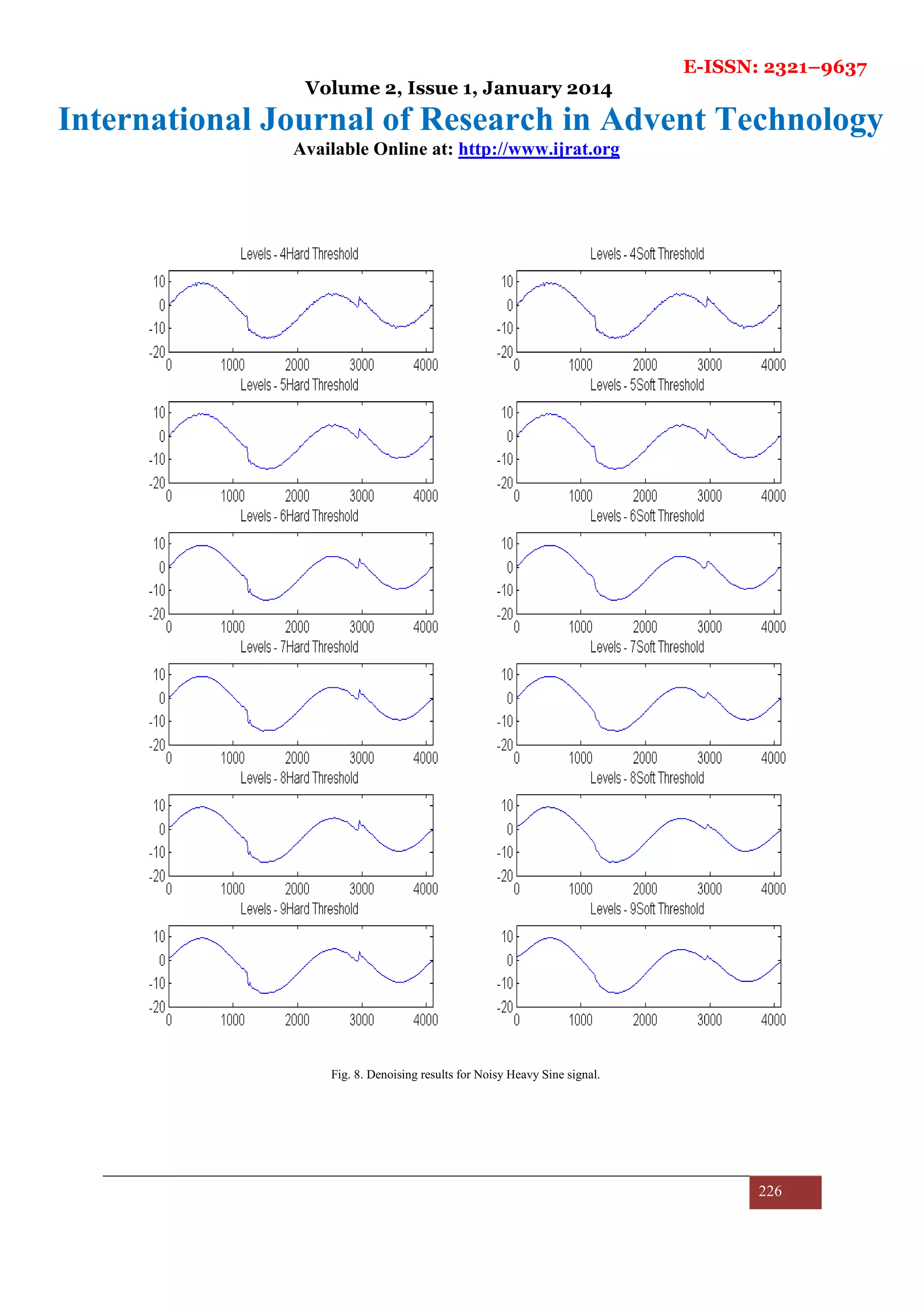
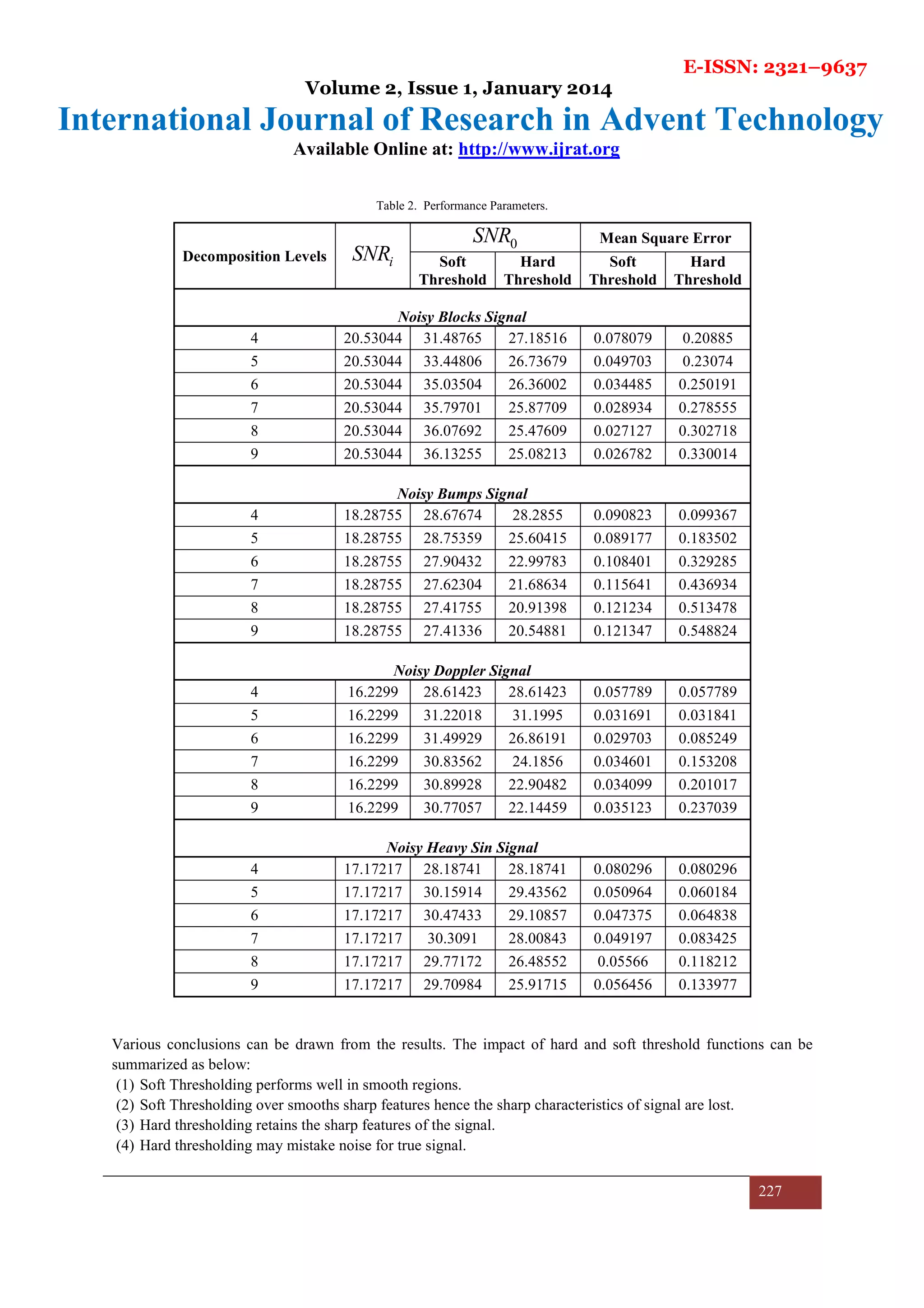
![E-ISSN: 2321–9637
Volume 2, Issue 1, January 2014
International Journal of Research in Advent Technology
Available Online at: http://www.ijrat.org
228
Also, on increasing the decomposition levels of the signal, the performance drops for soft threshold function
while it rises up to a certain level and then drops a little and finally saturates for hard threshold function. MSE
performance shown by the algorithm in almost all the cases is quite good which can be inferred from Table 2.
References
[1] Donoho D. L., Johnstone I. M. (1992): Minimax estimation via wavelet shrinkage. Technical Report, Department of Statistics,
Stanford University, 1992.
[2] Donoho D. L., Johnstone I. M. (1994): Ideal spatial adaptation by wavelet shrinkage, Biometrika 81, 1994, pp. 425–455.
[3] Albert C.To, Jeffrey R. Moore, Steven D. Glaser (2008): Wavelet denoising techniques with applications to experimental geophysical
data. Signal Processing, 2008 ELSEVIER B.V.
[4] Stephane S.G., Mallat G.(2009): A Wavelet Tour of Signal Processing. The Sparse Way, 3rd Edition 2009.
[5] Donoho D. L. (1995): De-noising by soft thresholding. IEEE Transactions on Information Theory, Vol. 41, No. 3, May 1995, pp. 613–
627.
[6] Donoho D. L., Johnstone I. M. (1995): Adapting to Unknown Smoothness via Wavelet Shrinkage. Journal of American Statistical
Association, Vol. 432, No. 90, December 1995, pp. 1200-1224.
[7] Cheng Chen, Ningning Zhou (2012): A new wavelet hard threshold to process image with strong Gaussian Noise. IEEE Fifth
International Conference on Advanced Computational Intelligence (ICACI), 18-20 Oct. 2012, pp.558,561,
[8] Donoho D. L., Johnstone I. M. (1994):Threshold selection for wavelet shrinkage of noisy data. Engineering in Medicine and Biology
Society, 1994.
[9] Satish L., Nazneen B. (2003): Wavelet-based denoising of partial discharge signals buried in excessive noise and interference, IEEE
Transactions on Dielectrics and Electrical Insulation, Vol. 10, No. 2, 2003, pp. 354-367.
[10] Vigneshwaran B., Maheswari R. V., Subburaj P. (2013): An improved threshold estimation technique for partial discharge signal
denoising using Wavelet Transform. International Conference on Circuits, Power and Computing Technologies (ICCPCT), 20-21
March 2013, pp.300,305.
[11] Advanced Digital Signal Processing - Wavelets and multirate, Lectures by Prof.V.M.Gadre, Department of Electrical Engineering, IIT
Bombay, http://nptel.iitm.ac.in
[12] Rao R. M., Bopardikar A. S.: Wavelet Transforms: Introduction to Theory and Applications. Rochester Institute of Tech Addison-
Wesley.
[13] Oppenheim A. V., Schafer R.W. (1989): Discrete-Time Signal Processing. Englewood Cliffs, NJ: Prentice-Hall.
[14] Sarita Dangeti (2003): Denoising Techniques - A Comparison. M.S. thesis, Graduate Faculty of the Louisiana State University and
Agricultural and Mechanical College
Rashmi Gupta received degree in Electronics and Communication Engineering from Institute of
Electronics and Telecommunication Engineering, Delhi. M.E. in Electronics and Communication
Engineering from Delhi University and is currently pursuing Ph.D. on topic “Designing a global
framework for non-linear dimension reduction” from Delhi University. She worked in Calcom group of
companies, Hindu Institute of Technology, Maharaja Agrasen Institute of Technology, Delhi. She is
currently working as Associate Professor in Ambedkar Institute of Advanced Communication
Technologies and Research, Delhi. She has authored over 18 research papers in various
International/National journals and conferences. She is member of IEEE and life member of IETE.
Hemant Tulsani received degree in Electronics and Communication Engineering from Guru Gobind
Singh Indraprastha University, Delhi. He is currently a research scholar at Ambedkar Institute of
Advanced Communication Technologies and Research, Delhi. He has authored 5 research papers in
International journals and conferences.](https://image.slidesharecdn.com/paperid-21201498-140828020852-phpapp01/75/Paper-id-21201498-13-2048.jpg)